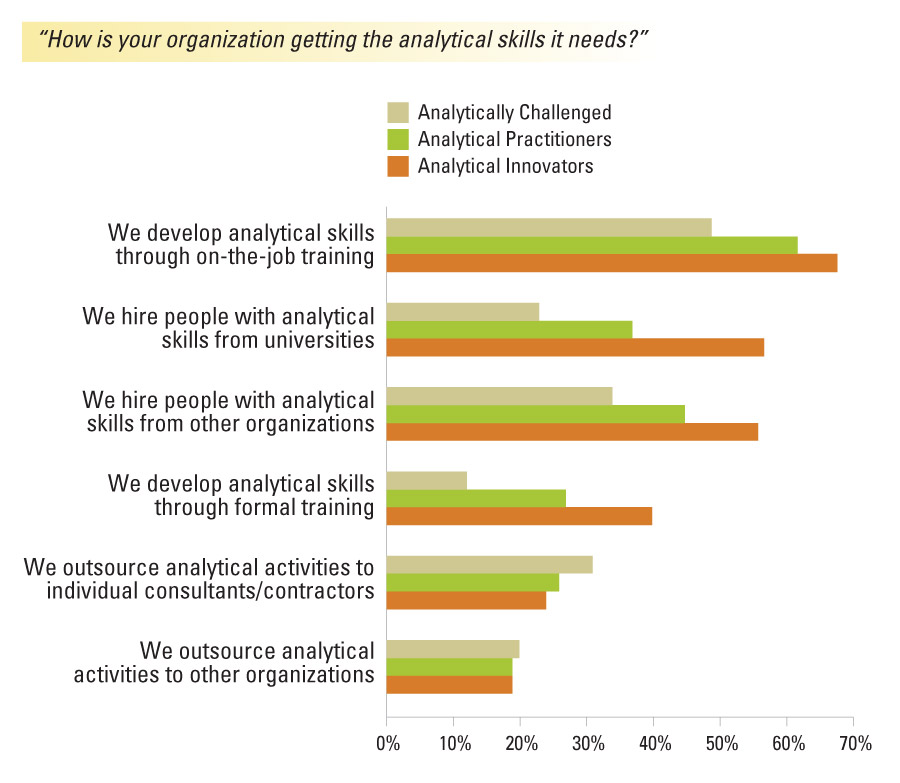Participant Questions from the Recent Data & Analytics Webinar
We’re taking a little time to answer some of the questions we didn’t get to in our webinar Q&A session.
Topics
Competing With Data & Analytics
On May 7, 2015, we held a free, live webinar to share the findings and insights from the latest MIT Sloan Management Review Data and Analytics Big Idea Initiative research report, “The Talent Dividend.” The report presents our findings on the role of analytics talent in creating competitive advantage.
If you missed the webinar live, the recorded version is available for viewing. Thanks to everyone that participated in the webinar — we had far more people than we expected.
At the end of the webinar, many participants asked questions. Unfortunately, we didn’t have time to answer them all during the webinar itself. So instead, we’ll answer some of the questions this month, and some next month. Sorry that we still won’t be able to get to them all, but we hope we’ve covered the ones asked by the most people. We’ve paraphrased some of the questions to provide context, combine similar questions and make them anonymous. So, here’s our first question:
Have there been efforts to link high versus low analytic performers to actual success in the marketplace? Are Analytically Challenged companies less profitable in their respective market segments?
Yes. One of the questions that we ask in the annual survey is about financial performance change over the last year. Analytical maturity is associated with better financial performance. Last year’s report, “The Analytics Mandate,” includes these details. The percentage of respondents stating that their organization’s revenue “was better this most recent fiscal year, compared to the previous year” differs considerably by analytical maturity. From last year’s report, 51% of Analytically Challenged organizations, 64% of Analytical Practitioners, and 80% of Analytical Innovators report improvement in organizational revenue. As you noticed, we didn’t include those details in this year’s report. The results were similar this year, but we didn’t see enough change in these responses to highlight them.
Do you think the deficit in analytical talent is in quantitative skills (e.g., data mining, statistics) or in understanding business (e.g., strategy, operations, etc.)?
We see a need for analytical talent in both quantitative and business areas.
We asked respondents what their biggest analytical skills gaps were. During the webinar, we reported on some of this:
- Translating analytics into business strategy or specific actions: 51%
- Asking the right questions: 30%
- Knowing what data to analyze: 28%
None of these fall into the category of true quantitative skills. Instead, only 18% reported a deficit in “statistics, math, or other quantitative skills”; 25% reported a deficit in “data analysis/mining.” Certainly, organizations feel quantitative gaps; however, more respondents felt these non-quantitative gaps. We found these differences enlightening. We have another article based on this research, “Minding the Analytics Gap”, that discusses the implications of the combination of these two types of gaps on organizations.
Companies Seek Analytical Skills From a Variety of Sources
Analytically mature organizations are more aggressive than others in hiring outside talent.
How much of the solution to an analytical talent gap comes from “formal” training via Master’s, PhD, or MBA degrees?
There are a couple of different ways that formal training could occur. First, as you note, there are the classic university degree programs. These are increasingly being augmented by specialized Master’s degree programs. Our research finds that, in aggregate, 35% of respondents report hiring people with analytical skills from universities. Our report breaks this down by analytical maturity (see the Chapter 4 graphic entitled, “Companies Seek Analytical Skills From a Variety of Sources,” below).
However, there is a considerable variety of formal training programs other than university degree programs, such as executive education, certificate programs, in-house training content, etc. We find that, in aggregate, 23% of respondents develop analytical skills through these types of formal training programs; again, the report itself breaks this down further by analytical maturity. Currently, though, on-the-job training is the largest resource, with 58% of the respondents reporting some form of on-the-job training.


 View Exhibit
View Exhibit